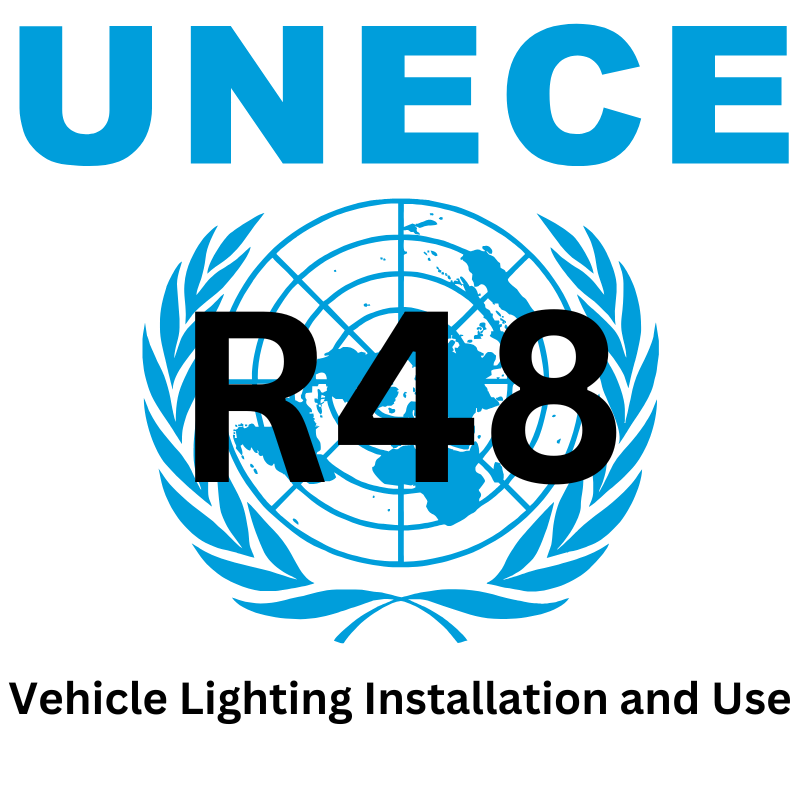Guide To: UNECE R48 - Vehicle Lighting Installation and Use
02 February 2022

Guide To: UNECE R48 - Vehicle Lighting Installation and Use
UN ECE Regulation No. 48 provides the uniform provisions concerning the installation of lighting and light-signalling devices on vehicles. This regulation ensures that lighting systems are designed and installed in a way that enhances vehicle safety, visibility, and communication with other road users. It covers both exterior lighting devices, such as headlights and brake lights, and signalling devices, such as indicators and hazard lights.
Scope of the Regulation
UN ECE R48 applies to:
- Vehicles of categories M, N, and O (which include passenger cars, trucks, and trailers) regarding the installation of all lighting and light-signalling devices.
Key Features of UN ECE R48
General Installation Requirements:
- The regulation defines specific installation rules for each type of lighting and signalling device. These include placement, alignment, light intensity, and light distribution to ensure proper functionality and prevent glare or confusion for other drivers.
- Lights must be installed so that their signals are clearly visible under different environmental conditions, such as darkness, fog, or heavy rain.
Specific Installation Requirements:
- Headlights (Main-Beam and Dipped-Beam): The regulation specifies the height and positioning of both dipped and main-beam headlights to ensure they properly illuminate the road ahead without dazzling other drivers.
- Rear Lighting and Signalling Devices: Rear lights, brake lights, and rear fog lamps must be visible from specific angles and distances, ensuring that other road users can detect a vehicle from behind even in poor visibility.
- Side-Marker Lamps: These lamps are mandatory for certain vehicles to enhance visibility from the side, particularly for large vehicles and trailers.
Variable Intensity Control:
- Some light-signalling devices, such as brake lights and rear fog lamps, may be equipped with variable intensity controls to adapt to environmental or traffic conditions. For example, the intensity of the rear lights can adjust based on fog or snow to prevent excessive glare.
Driver Assistance Projections:
- The regulation allows for driver assistance projections, which modify light distribution for driver assistance purposes. These are designed to improve the driver's awareness in complex environments, such as tight parking spaces.
Safety Provisions:
- To prevent accidents and confusion, red lights must not be visible from the front of the vehicle, and white lights (except for reversing lights) must not be visible from the rear.
- Hazard warning signals, headlights, and other important safety lights must be designed to be easily recognizable, ensuring effective communication of a vehicle’s actions.
Incorporation into UN ECE R148
While UN ECE R48 governs the installation of lighting and light-signalling devices, the technical requirements for the design and performance of these devices (such as the specifications for the lights themselves) are covered under UN ECE Regulation No. 148. R148 consolidates and standardizes the requirements for all light-signalling devices, making it the primary regulation for the approval of these devices. Therefore, lighting systems that meet R148 are deemed suitable for installation under the requirements of R48.
Conclusion
UN ECE R48 ensures that vehicle lighting and signalling systems are installed in a way that maximizes safety, visibility, and communication. By adhering to the installation standards set out in this regulation, manufacturers can ensure that vehicles are equipped with lighting systems that meet international safety standards. When combined with the technical standards from R148, this regulation ensures that lighting devices are both properly designed and correctly installed.